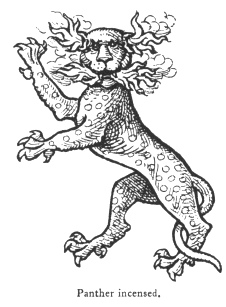
Masonic, Occult and Esoteric Online Library
Fictitious and Symbolic Creatures in Art
By John Vinycomb
Other Chimerical Creatures and Heraldic Beasts-The Panther Incensed
"The panther, knowing that his spotted hide
Doth please all beasts, but that his looks them fray,
Within a bush his dreadful head doth hide
To let them gaze, while he on them doth prey."
Spenser, Sonnet.
This beast, like the leopard, has been the object of much mistaken or fictitious history. Pliny, who is responsible for many of the errors in natural history since his time, says of the panther: "It is said that all four-footed beasts are wonderfully delighted and enticed by the smell of panthers; but their hideous looke and crabbed countenance which they bewray so soon as they show their heads skareth them as much again: therefore their manner is to 
hide their heads, and when they have trained other beasts within their reach by their sweet savour, they fall upon them and worry them." * And again, Sir William Segar, Garter King-of-Arms, following the same credulous historian, says: "The panther is admired of all other beasts for the beauty of his skyn, being spotted with variable colours, and beloved of them for the sweetness of his breath that streameth forth of his nostrils and ears like smoke which our paynters mistaking, corruptly do make fire." †
It is, however, more probable that the creature was represented emitting flame and smoke to denote and give characteristic expression to the native savagery of the brute when irritated. If one can imagine the terror inspired by remorseless and unpitying fury, sudden and impetuous, we see its object fairly typified in the panther incensed." The idea of fire and smoke darting from its mouth, eyes and ears was doubtless suggested by that habit peculiar to the feline race, observable even in the domestic cat, to "spit fire" and "swear" when rudely attacked, and as an emblem in this sense it is extremely well indicative of sudden fury.
Guillam says: "Some authors are of opinion that there are no panthers bred in Europe; but in Africa, Lybia and Mauritania they are plentiful. The panther is a beast of a beautiful aspect, by reason of the manifold variety of his divers coloured spots wherewith his body is overspread. As a lion doth in most things resemble the nature of a man, so, after a sort, doth the panther of a woman; for it is a beautiful beast, and fierce, yet very loving to their young ones, and will defend them with the hazard of their own lives; and if they miss them, they bewail their loss with loud and miserable howling."
The Lancastrian badge "the panther," says Planché, "which is attributed by Sir William Segar to Henry VI. and blazoned passant guardant argent spotted of all colours with vapour issuant from her mouth and ears; but there is no authority quoted for it, and there is no example extant, the only collateral evidence being the supporters of the Somerset Dukes of Beaufort, who are supposed to have used it as a token of their Lancastrian descent." The dexter supporter of the Duke of Beaufort thus is blazoned: Dexter, a panther argent, semée of torteaux, hurts and pomies alternately, flames issuant from the mouth and ears proper, gorged with a plain collar, and chained, or.
The heraldic panther, or as it is more frequently termed, a panther incensed, is always borne guardant, i.e., full-faced; and "incensed," that is to say, it is depicted with flames and smoke issuing from its mouth and ears. Its coat is spotted of various tinctures as the blazon may state.
Odet de Foix, Sieur de Lautrec, Marshal of France (+ 1528) being considered a person of fierce appearance, took for device a panther, with the motto "Allicit ulterius" ("He entices further"), alluding to the attractive power of that animal notwithstanding its fierce exterior, "an evidence," remarks a modern writer, "that he had as much vanity as ambition."
The town of Lucca for arms bears a panther: "La pantera, che Lucca abbraccia e onora."
Gian Giacomo Trivulzio, surnamed the Great (+ 1518), a celebrated Italian soldier, bore a panther on his standard, with the motto, "Mens sibi conscia facti" ("The mind conscious to itself of the deed"), the panther signifying foresight (providence) from the number of eyes in his coat. Others said he wished to imply that he knew how to manage for himself in the various changes of his capricious fortune. *
Footnotes
200:* Bk. viii. ch. 17.
200:† Harl. MSS. 6085.
202:* Hist. Dev. 260.
